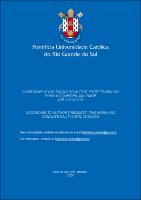| Share record |


|
Please use this identifier to cite or link to this item:
https://tede2.pucrs.br/tede2/handle/tede/9169Full metadata record
| DC Field | Value | Language |
|---|---|---|
| dc.creator | Dalenogare Neto, Waldemar | - |
| dc.creator.Lattes | http://lattes.cnpq.br/0065095418213859 | por |
| dc.contributor.advisor1 | Silveira, Helder Volmar Gordim da | - |
| dc.date.accessioned | 2020-07-20T12:09:19Z | - |
| dc.date.issued | 2020-03-30 | - |
| dc.identifier.uri | http://tede2.pucrs.br/tede2/handle/tede/9169 | - |
| dc.description.resumo | Esta tese de doutorado tem como objetivo discutir a participação dos Estados Unidos na Operação Condor através da análise dos documentos liberados pelo Departamento de Estado e pela Central Intelligence Agency (CIA). Analisa-se o contexto pós-Segunda Guerra Mundial e a era da contrainsurgência na inteligência estadunidense, que seriam ecoadas na política externa dos EUA para o Cone Sul durante a administração Nixon/Ford através do Secretário de Estado, Henry Kissinger, e sua realpolitik. Os Estados Unidos sabiam da existência da Operação Condor, deram apoio logístico para a implementação do sistema de comunicação – CONDORTEL – e registraram os passos desta estrutura repressiva. Nunca houve, no entanto, uma nota de repúdio – e a única tentativa de démarche proposta pelo Departamento de Estado sobre o tema seria abandonada ainda em 1976. Com Jimmy Carter e sua política externa de direitos humanos, existe, no primeiro ano de mandato, uma forte pressão nos países do Cone Sul. Junto da reestruturação da CIA, que trocou seu método para a inteligência de sinais, e da tentativa de ruptura com a ordem geopolítica de Kissinger, Carter recebeu duras críticas e questionamentos por deixar em segundo plano e romper relações com os tradicionais parceiros do Cone Sul. Analisa-se o caso Letelier, as ameaças registradas pela CIA e os desdobramentos internos da Condor – como a Operação Teseo. Já em 1978, existe uma guinada na política externa de Carter, aprofundada com as crises subsequentes no Irã e Afeganistão, que colocariam a política externa dos direitos humanos em segundo plano. A Condor, aos poucos, levaria sua estrutura repressiva para a América Central, na Operação Charly. | por |
| dc.description.abstract | This doctoral thesis discusses the United States participation in Operation Condor through the analysis of documents released by the U.S State Department and the Central Intelligence Agency (CIA). I analyze the post-World War II context and the era of counterinsurgency in American intelligence, which would be echoed in U.S foreign policy towards the southern cone during the Nixon/Ford administration through Secretary of State Henry Kissinger and his realpolitik. The United States knew the existence of Operation Condor, provided logistical support for the implementation of the communication system - CONDORTEL - and recorded the steps of this repressive structure. There was never, however, a disapproval note - and the only U.S State Department proposal for a démarche on the subject was abandoned in 1976. With Jimmy Carter and his human rights foreign policy, in the first year of his term there was a strong diplomatic pressure directed towards the southern cone countries. Along with the restructuring of the CIA, which changed its method to signal intelligence, and also the attempt to break with Kissinger's geopolitical order in State Departament, Carter received harsh criticism for breaking relations with the traditional southern cone partners. The Letelier case, the threats registered by the CIA and the internal developments of Condor - such as Operation Teseo, are also discusses. In 1978, however, there was a shift in Carter's foreign policy, deepened by the subsequent crises in Iran and Afghanistan, which would put foreign human rights policy in the background. Condor, slowly, would take its repressive structure to Central America, in Operation Charly. | eng |
| dc.description.provenance | Submitted by PPG História ([email protected]) on 2020-05-21T18:36:59Z No. of bitstreams: 1 Tese Waldemar Dalenogare Neto .pdf: 1857767 bytes, checksum: 299179273582dc47cb8655fb71309b5b (MD5) | eng |
| dc.description.provenance | Approved for entry into archive by Clarissa Selbach ([email protected]) on 2020-07-20T11:57:02Z (GMT) No. of bitstreams: 1 Tese Waldemar Dalenogare Neto .pdf: 1857767 bytes, checksum: 299179273582dc47cb8655fb71309b5b (MD5) | eng |
| dc.description.provenance | Made available in DSpace on 2020-07-20T12:09:19Z (GMT). No. of bitstreams: 1 Tese Waldemar Dalenogare Neto .pdf: 1857767 bytes, checksum: 299179273582dc47cb8655fb71309b5b (MD5) Previous issue date: 2020-03-30 | eng |
| dc.description.sponsorship | Conselho Nacional de Pesquisa e Desenvolvimento Científico e Tecnológico - CNPq | por |
| dc.format | application/pdf | * |
| dc.thumbnail.url | http://tede2.pucrs.br:80/tede2/retrieve/178330/TES_WALDEMAR_DALENOGARE_NETO_CONFIDENCIAL.pdf.jpg | * |
| dc.language | por | por |
| dc.publisher | Pontifícia Universidade Católica do Rio Grande do Sul | por |
| dc.publisher.department | Escola de Humanidades | por |
| dc.publisher.country | Brasil | por |
| dc.publisher.initials | PUCRS | por |
| dc.publisher.program | Programa de Pós-Graduação em História | por |
| dc.rights | Acesso Aberto | por |
| dc.subject | Estados Unidos | por |
| dc.subject | Operação Condor | por |
| dc.subject | Política Externa | por |
| dc.subject | United States | eng |
| dc.subject | Condor Operation | eng |
| dc.subject | Foreign policy | eng |
| dc.subject.cnpq | CIENCIAS HUMANAS::HISTORIA | por |
| dc.title | Os Estados Unidos e a Operação Condor | por |
| dc.type | Tese | por |
| dc.restricao.situacao | Trabalho será publicado como artigo ou livro | por |
| dc.restricao.prazo | 60 meses | por |
| dc.restricao.dataliberacao | 20/07/2025 | por |
| Appears in Collections: | Programa de Pós-Graduação em História | |
Files in This Item:
| File | Description | Size | Format | |
|---|---|---|---|---|
| TES_WALDEMAR_DALENOGARE_NETO_CONFIDENCIAL.pdf | TES_WALDEMAR_DALENOGARE_NETO_CONFIDENCIAL | 366.2 kB | Adobe PDF |  Download/Open Preview |
Items in DSpace are protected by copyright, with all rights reserved, unless otherwise indicated.




